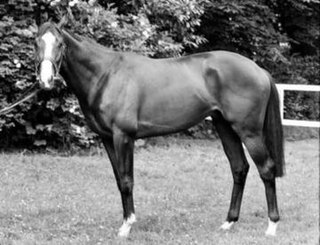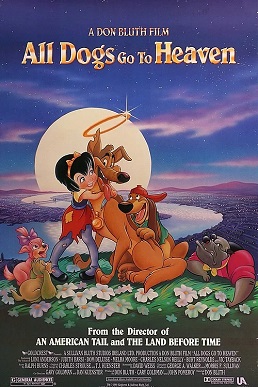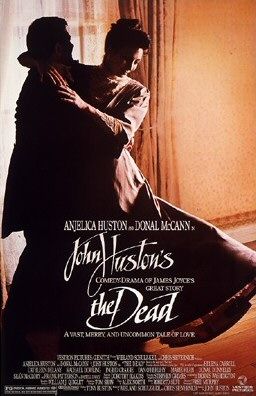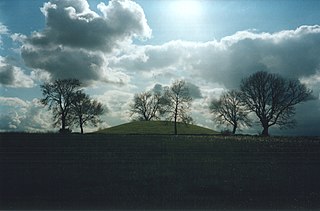
Shergar was an Irish-bred, British-trained Thoroughbred racehorse. After a very successful season in 1981 he was retired to the Ballymany Stud in County Kildare, Ireland. In 1983 he was stolen from the stud, and a ransom of £2 million was demanded; it was not paid, and negotiations were soon broken off by the thieves. In 1999 a supergrass, formerly in the Provisional Irish Republican Army (IRA), stated they stole the horse. The IRA has never admitted any role in the theft.

Gabriel James Byrne is an Irish actor. He has received a Golden Globe Award as well as nominations for a Grammy Award, two Primetime Emmy Awards and two Tony Awards. Byrne was awarded the Irish Film and Television Academy Lifetime Achievement Award in 2018 and was listed at number 17 on The Irish Times list of Ireland's greatest film actors in 2020. The Guardian named him one of the best actors never to have received an Academy Award nomination.

All Dogs Go to Heaven is a 1989 animated musical fantasy comedy-drama film directed by Don Bluth and co-directed by Gary Goldman and Dan Kuenster. Set in New Orleans in 1939, it tells the story of Charlie B. Barkin, a German Shepherd that is murdered by his former friend, Carface Carruthers. Charlie escapes from Heaven to return to Earth where his best friend, Itchy Itchiford, still lives, in order to take revenge on Carface. Instead, he ends up befriending a young orphan girl named Anne-Marie. In the process, Charlie learns an important lesson about kindness, friendship and love.

Ellen Rona Barkin is an American actress. Her breakthrough role was in the 1982 film Diner, and in the following years, she had starring roles in films such as Tender Mercies (1983), Eddie and the Cruisers (1983), The Adventures of Buckaroo Banzai Across the 8th Dimension (1984), The Big Easy (1986), Johnny Handsome, and Sea of Love.

The Dead is a 1987 drama film directed by John Huston, written by his son Tony Huston, and starring his daughter Anjelica Huston. It is an adaptation of the short story of the same name by James Joyce, which was first published in 1914 as the last story in Dubliners. An international co-production between the United Kingdom, the United States, and West Germany, the film was Huston's last as director, and it was released several months after his death.

Oisín, Osian, Ossian, or anglicized as Osheen was regarded in legend as the greatest poet of Ireland, a warrior of the Fianna in the Ossianic or Fenian Cycle of Irish mythology. He is the demigod son of Fionn mac Cumhaill and of Sadhbh, and is the narrator of much of the cycle and composition of the poems are attributed to him.

Dunston Checks In is a 1996 Canadian-American children's comedy film directed by Ken Kwapis. The film stars Eric Lloyd, Graham Sack, Jason Alexander, Faye Dunaway, Rupert Everett, Paul Reubens, Glenn Shadix, and Sam the Orangutan as Dunston. The film received negative reviews on Rotten Tomatoes and grossed $10 million against a budget of $16 million.
Conroy is an Irish surname.

BBC Film is the feature film-making arm of the BBC. It was founded on 18 June 1990, and has produced or co-produced some of the most successful British films of recent years, including Truly, Madly, Deeply, Alan Partridge: Alpha Papa, Quartet, Salmon Fishing in the Yemen, Saving Mr. Banks, My Week with Marilyn, Eastern Promises, Match Point, Jane Eyre, In the Loop, An Education, StreetDance 3D, Fish Tank, The History Boys, Nativity!, Iris, Notes on a Scandal, Philomena, Stan & Ollie, Man Up, Billy Elliot and Brooklyn.

Naomh Maur is a Gaelic Athletic Association club based in Rush, Dublin, Ireland. The club was founded in 1928.
The 7th Irish Film & Television Awards took place on 20 February 2010 in the Burlington Hotel, Dublin. It was hosted by Victoria Smurfit and honoured Irish film and television released in 2009.

The royal sites of Ireland were the seats of the Gaelic kings of Ireland. Medieval sources describe them as the ceremonial capitals of various Irish kingdoms, where kingly inaugurations, assemblies and athletic games were held. Archaeological investigations show that many royal sites were culturally significant for thousands of years before recorded history, and they often include ancient monuments such as Neolithic burial mounds, standing stones, cairns and enclosures.
Ciarán Fitzgerald is an Irish former film and television actor. He is best known for his role as Ossie Reilly in the 1992 film Into the West, which earned him a Young Artist Award. He has also appeared in films, such as, Nothing Personal (1995), Some Mother's Son (1996), The Last of the High Kings (1996), The Boxer (1997), and The General (1998).
Sophie Toscan du Plantier, a 39-year-old French woman, was killed outside her holiday home near Toormore, Goleen, County Cork, Ireland, on the night of 23 December 1996.
The 8th Irish Film & Television Awards were held on 12 February 2011 in the Convention Centre, Dublin.

The Field is a 1990 Irish drama film written and directed by Jim Sheridan and starring Richard Harris, John Hurt, Sean Bean, Brenda Fricker and Tom Berenger. It was adapted from John B. Keane's 1965 play of the same name. The film is set in the early 1930s and was shot almost entirely in the Connemara village of Leenaun.
The 15th Youth in Film Awards ceremony, presented by the Youth in Film Association, honored outstanding youth performers under the age of 21 in the fields of film, television and theatre for the 1992-1993 season, and took place on February 5, 1994, at the Sportsmen's Lodge in Studio City, California.

Rory is a given name of Gaelic origin. It is an anglicisation of the Irish: Ruairí/Ruaidhrí and Scottish Gaelic: Ruairidh/Ruaraidh and is common to the Irish, Highland Scots and their diasporas. The meaning of the name is "red king", composed of ruadh ("red") and rígh ("king").












